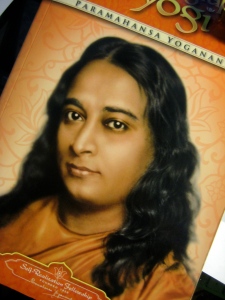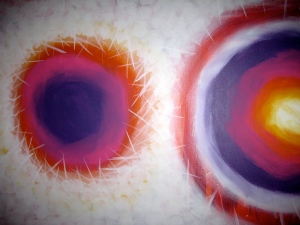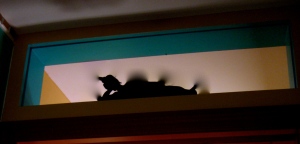
Almost every morning, as Jan channels the Soulbyte for the day, I go off and open a book at random to let the divine deliver its message to me.
The other day, I opened Autobiography of a Yogi to an interaction between Yogananda and his master Sri Yukteswar. Yogananda had just experienced a great physical healing, which he thanked his master for. Sri Yukteswar craftily worded his response to suggest that the healing was actually effected by a change in Yogananda’s own thought process. Yogananda anxiously sought to disavow this power and the next day awoke completely unable to physically get out of bed, restored to the comfort of the familiarity of his old weakness. Sri Yukteswar then instructed: “The human mind is a spark of the almighty consciousness of God…whatever your powerful mind believes very intensely would instantly come to pass.”
Can we take ownership of that Divine Spark, that God within us all? Can we wisely direct our thoughts toward greater union within ourselves, within the world? Are we ready to take full ownership of our power?
On another recent morning, enveloped in a mood of despair and stagnation, as Jan channeled, I turned to the I Ching for guidance. Not surprisingly, hexagram #12, Stagnation, appeared. Here heaven and earth are flying further and further apart, deeply out of alignment with each other.
It’s hard now to not see the signs of this dissociation every day, whether it be beached whales, fish fleeing the too warm waters of Maine, children slaughtered at school, women brutally raped, and the stories go on and on. We are in a time of total disintegration as nature and spirit dissolve the world as we have known it and move toward a new position, rebalancing into a new and sustainable format.
The I Ching tells me (nine in the fourth place) that the time of stagnation is nearing the point of change into its opposite. And finally, nine at the top, that though this time of standstill does not last forever, it does not cease of its own accord either; the right leader is needed.
Here I am led back to my opening quote, stating that the spark of God resides in every person. Every person is and has the power of God within, and that power lies in the power of intent. But we must truly embrace that power and believe it to effect the change we seek. One danger, of course, is to misuse that power. This has been the mistake of our human race to date, to exploit our Godly power to our own advantage: narcissistic greed. That mistake has brought us to this edge of oblivion.
Yesterday morning, I opened Autobiography of a Yogi again, to this quote regarding how to use our power: “Don’t do what you like, then do everything you like.” The guidance is clear. Ego must first check its narcissistic impulse to act. This impulse is cut off from the needs of the interdependent whole, just as the I Ching suggests that the earth and the heavens are cut off from each other, each swirling in opposite directions away from unity and wholeness. It’s all about me, me, me. If we pause, we give ourselves the opportunity to realign, to become the interdependent whole that then is freed to act with abandon, offered the opportunity to achieve true unity based on right alignment, with ego serving the Spark of the Divine.

– Art by Jan Ketchel
Synchronistically, I turned on the news the other day to hear that two leaders have acted as real leaders, serving the interdependent needs of the whole, Cuomo and Obama. New York Governor Cuomo refused the interests of the fossil fuels industry to value Mother Earth and our true needs. NO FRACKING in New York. Bravo, Governor Cuomo! President Obama has established diplomatic ties with Cuba, ending a long divide. Bravo, President Obama!
Let us all be our own Godly leaders, exercising our own Spark of the Divine. Let us all have pure thoughts of greater union, of care of the true needs of the whole, of heaven and earth, of self and other.
Happy Holidays!
Chuck


